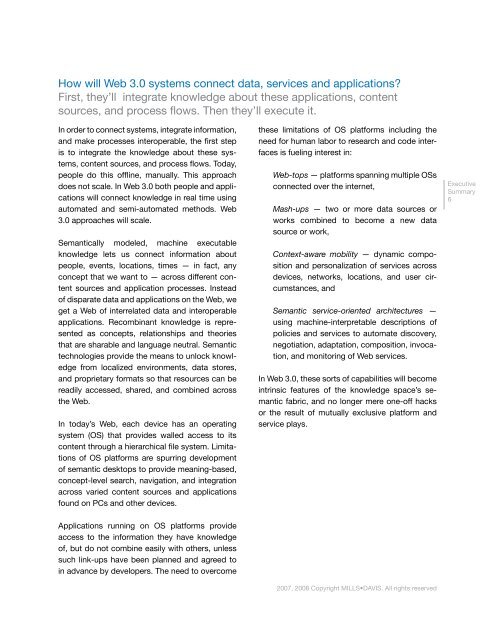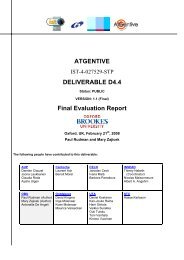Industry Roadmap to Web 3.0 & Multibillion Dollar ... - INSEAD CALT
Industry Roadmap to Web 3.0 & Multibillion Dollar ... - INSEAD CALT
Industry Roadmap to Web 3.0 & Multibillion Dollar ... - INSEAD CALT
You also want an ePaper? Increase the reach of your titles
YUMPU automatically turns print PDFs into web optimized ePapers that Google loves.
How will <strong>Web</strong> <strong>3.0</strong> systems connect data, services and applications?<br />
First, they’ll integrate knowledge about these applications, content<br />
sources, and process flows. Then they’ll execute it.<br />
In order <strong>to</strong> connect systems, integrate information,<br />
and make processes interoperable, the first step<br />
is <strong>to</strong> integrate the knowledge about these systems,<br />
content sources, and process flows. Today,<br />
people do this offline, manually. This approach<br />
does not scale. In <strong>Web</strong> <strong>3.0</strong> both people and applications<br />
will connect knowledge in real time using<br />
au<strong>to</strong>mated and semi-au<strong>to</strong>mated methods. <strong>Web</strong><br />
<strong>3.0</strong> approaches will scale.<br />
Semantically modeled, machine executable<br />
knowledge lets us connect information about<br />
people, events, locations, times — in fact, any<br />
concept that we want <strong>to</strong> — across different content<br />
sources and application processes. Instead<br />
of disparate data and applications on the <strong>Web</strong>, we<br />
get a <strong>Web</strong> of interrelated data and interoperable<br />
applications. Recombinant knowledge is represented<br />
as concepts, relationships and theories<br />
that are sharable and language neutral. Semantic<br />
technologies provide the means <strong>to</strong> unlock knowledge<br />
from localized environments, data s<strong>to</strong>res,<br />
and proprietary formats so that resources can be<br />
readily accessed, shared, and combined across<br />
the <strong>Web</strong>.<br />
In <strong>to</strong>day’s <strong>Web</strong>, each device has an operating<br />
system (OS) that provides walled access <strong>to</strong> its<br />
content through a hierarchical file system. Limitations<br />
of OS platforms are spurring development<br />
of semantic desk<strong>to</strong>ps <strong>to</strong> provide meaning-based,<br />
concept-level search, navigation, and integration<br />
across varied content sources and applications<br />
found on PCs and other devices.<br />
these limitations of OS platforms including the<br />
need for human labor <strong>to</strong> research and code interfaces<br />
is fueling interest in:<br />
<strong>Web</strong>-<strong>to</strong>ps — platforms spanning multiple OSs<br />
connected over the internet,<br />
Mash-ups — two or more data sources or<br />
works combined <strong>to</strong> become a new data<br />
source or work,<br />
Context-aware mobility — dynamic composition<br />
and personalization of services across<br />
devices, networks, locations, and user circumstances,<br />
and<br />
Semantic service-oriented architectures —<br />
using machine-interpretable descriptions of<br />
policies and services <strong>to</strong> au<strong>to</strong>mate discovery,<br />
negotiation, adaptation, composition, invocation,<br />
and moni<strong>to</strong>ring of <strong>Web</strong> services.<br />
In <strong>Web</strong> <strong>3.0</strong>, these sorts of capabilities will become<br />
intrinsic features of the knowledge space’s semantic<br />
fabric, and no longer mere one-off hacks<br />
or the result of mutually exclusive platform and<br />
service plays.<br />
Executive<br />
Summary<br />
6<br />
Applications running on OS platforms provide<br />
access <strong>to</strong> the information they have knowledge<br />
of, but do not combine easily with others, unless<br />
such link-ups have been planned and agreed <strong>to</strong><br />
in advance by developers. The need <strong>to</strong> overcome<br />
2007, 2008 Copyright MILLS•DAVIS. All rights reserved
















